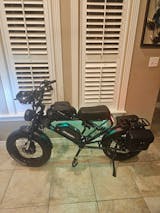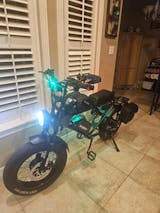Table of Contents
Conversion of a conventional motorized wheel allows faster driving with less effort. By adding a bike set, your regular bike becomes an electric bike offering additional power for commuting or recreational purposes.
For bikes there are two primary conversion sets: gas -powered wheel conversions and electric wheel conversion. The gas system relies on a small internal combustion engine that offers higher speeds and longer range, while the electrical conversion is based on the engine technology on the battery wheels and provides quieter power, which is also more environmentally friendly.
The advantages of upgrading to the motorized bicycle kit include increased speed, reduced pedaling efforts and higher efficiency for longer rides. Whether you have chosen gas or electrical conversion, upgrading your bike provides improved comfort and performance while remaining light and easy to handle.
Selecting the Appropriate Conversion Kit
The first step to transforming your bike into a motorized bicycle is selecting an engine conversion kit suitable for gas-powered or electric bike conversion. There are two primary options to consider here, gas conversion and electric conversion.
Gas-powered bike engine kits use small combustion engines, providing higher speed and longer range. Ideal for long distance travel, they require frequent fuel refills and maintenance checks; an electric bike conversion kit on the other hand offers quieter operation while being eco-friendly; however it depends on battery life for range per charge and may have limited range per charge.
When selecting a motorized bike kit, take into account budget, power output, installation ease and long-term maintenance needs. For beginners, user-friendly kits like an 80cc bicycle engine kit (gas) or 500W electric bike conversion kit may provide optimal balance of performance, affordability and ease of use.
Essential Tools and Materials
Before beginning to convert a motorized bicycle, gather all necessary tools and components. Being prepared will facilitate an easier installation process.
1. Required Tools
Assembly will require basic tools like wrenches for tightening bolts and adjusting components:
- Wrenches: used for tightening bolts and tightening components.
- Screwdrivers: Needed for fastening screws on bicycle engine kits or electric bike conversion kits.
- Drill: May be needed for custom mounting brackets.
- Chain Breaker Tool: Allows for adjusting chain length for proper tension.
- Pliers and Allen keys:These tools can be used for securing small parts and making adjustments.
2. Essential Parts
A motorized bike kit must include key components, including:
- Bicycle Motor: either gas- or electric-powered.
- Engine mount: Provides stability when mounting an engine to its frame.
- Throttle and clutch levers : Used for controlling speed and engaging the engine.
- Fuel tank(if gas-powered): Supplies fuel directly to the bicycle engine.
- Battery and Controller (if electric): Provide power to the conversion kit.
3. Safety Gear
Always wear protective gear:
- Helmet: essential for head protection during falls.
- Gloves: provide extra grip, protect hands from injuries.
- Protective eyewear: shield eyes from debris and wind while riding.
With all of this gear available to ensure a successful motorized bicycle conversion.
Step-by-Step Installation Guide
Converting a bicycle into a motorized bike requires precise installation for safe and efficient operation. This guide offers a step-by-step breakdown of each step involved, from prepping the bicycle through installing engine kits and configuring fuel or electrical systems.
A. Prep the Bicycle
Before beginning the installation of your motorized bicycle conversion, verify that its frame can support this change.
- Choose a strong and durable frame: A steel or reinforced aluminum frame is recommended, as they can withstand additional weight and vibrations caused by bicycle motors. Avoid carbon fiber frames which could crack under stress.
- Upgrade Brakes and Tires: Since motorized bikes move at much greater speeds, ensuring your braking system is reliable is of utmost importance. Install disc or high-performance caliper brakes for increased stopping power; install wider puncture-resistant tires for improved grip and stability; these upgrades should all help your bike achieve maximum control at every speed level.
- Reinforce Spokes and Rims: As the additional weight and torque from your bicycle engine puts undue stress on the wheels, check that spokes are tightened properly and that rims are durable enough to withstand increased speed.
B. Installing an Engine
Once your bicycle is assembled, begin installing its engine kit. Follow these steps carefully to ensure stability and proper function:
1. Mount Engine to Frame
- Mount the engine within the triangle area below the top tube for optimal weight distribution.
- Use the included mounting brackets and bolts to tighten it securely, avoiding movement or vibrations.
2. Attach the Drive Chain and Sprocket
- Attach the rear sprocket to the wheel while ensuring proper alignment.
- Connect and tension engine chain with rear sprocket ensuring no looseness is apparent in its movement. A properly tensioned chain should have some give but shouldn't be too loose.
3. Attach the Throttle and Clutch System
- Attach the throttle grip to the handlebars. Connect the throttle cable to either the carburetor (for gas-powered engines) or motor controller (for electric systems).
- Install a clutch lever and cable, making sure smooth engagement when pressing.
4. Secure Exhaust and Components
- Attach the exhaust pipe to the engine so it directs fumes away from you.
- Install a kill switch on your handlebars for quick engine shutdown in emergencies.
C. Set Up Electrical or Fuel Systems
Next steps depend on whether or not you are using an electric bike conversion kit:
1. For Electric Conversion:
- Securing battery and controller to frame ensure they are away from moving parts for safety reasons.
- Connect the motor to its controller, wiring the throttle properly.
- Double-check all electrical connections for electrical failures before continuing on with assembly.
2. For Gas-Powered Conversion:
- When mounting the fuel tank to the frame top bar, ensure it remains secure to prevent spillage of gasoline onto the ground during transit.
- Secure the fuel line between the tank and carburetor to prevent any leaks.
- And check that spark plug connections are secure while making sure appropriate settings for fuel/air mixture for smooth combustion.
Once your installation is complete, take time to review all bolts, chains and connections carefully. Make sure the throttle operates smoothly while checking that your brakes work effectively before taking your first test ride to verify that the bicycle engine starts correctly and runs without excessive vibration.
Watch this YouTube tutorial(https://www.youtube.com/watch?v=aIFk3gio2kA) to understand the steps of motorized bicycle conversion successfully and efficiently. By carefully following its steps, your bike will soon become motorized with increased speed and efficiency!
Testing and Adjustments
After installing the motorized bike kit, testing it thoroughly is crucial. Start by placing it on a level surface, turning on its engine/battery system, and watching for any unusual vibrations, noises or loose components that might suggest anything is amiss. Tighten the bolts or check their mounting brackets if any are proving unstable - tighten them until all issues have been addressed satisfactorily.
Next, test the throttle response to see how smoothly your bike accelerates. A slow or inconsistent acceleration may indicate improper cable tension or electrical connection issues; for gas-powered conversions ensure the engine idles appropriately without unexpected stalling; in an electric bike conversion kit make sure that consistent power reaches the motor.
Braking is also crucial. Give the brakes a good squeeze to assess their stopping power; if braking feels weak, adjust the pads or upgrade to a stronger system.
Once basic checks are complete, take your motorized bicycle out for a short test ride in an open and safe environment. Begin at low speed to assess stability, throttle control, and braking efficiency before gradually increasing speed while still ensuring smooth operation - this ensures both a safer and more enjoyable riding experience! Adjustments like these will make sure you enjoy an enjoyable riding experience.
Safety Precautions and Legal Considerations
Riding a motorized bicycle requires careful consideration for both its own safety and compliance with local laws. One key thing to be mindful of when riding in your area is speed regulations - many regions have restrictions that determine when a motorized bike becomes classified as a motorcycle and require further licensing/registration requirements, exceeding which could incur fines or legal issues.
Wearing appropriate protective gear is vital to road safety. A high-quality helmet helps minimize risks of head injuries while gloves provide superior grip and offer added protection from falls. Installing front and rear lights improves visibility in low light conditions or at night - and reflective elements on your clothing or frame further increase road safety.
Before riding, it is also crucial to familiarize yourself with local laws regarding bicycle engine upgrades. Understand municipal laws for gas-powered bike conversions since they mandate insurance coverage and special permits; compliance with these rules helps avoid legal problems and boost your safety as well as confidence during motorized bike conversion rides.
Maintenance and Troubleshooting
Routine maintenance checks on your motor motor motor engine are essential to be able to run effectively, prevent unexpected disorders and extend its life. Planning regular checks allows you to ensure that all components work optimally and at the same time extend its life.
1. Routine Checks
One of the most essential maintenance tasks is checking chain tension. A loose chain can slip off, while an overly tight one puts excessive wear and tear on engine and drivetrain components. Brakes should also be regularly checked to ensure adequate stopping power; in electric bike conversion kits, battery health monitoring should also be prioritized; weak or damaged batteries reduce power output and limit riding range.
2. Common Issues and Solutions
One of the most important maintenance tasks is to check the chain tension. The free chain can slip while too loose, while an overly tight gives excessive wear of the engine components and the driveway. The brakes should also be regularly checked to ensure sufficient stopping; In the sets for electric wheel conversions, the priority of battery health monitoring should also be a priority; Weak or damaged batteries reduce power and reduce the driving range.
3. Tips for Longevity
If you want to keep the motorized bike in the run best, ensure regular engine cleaning, lubrication of the chain and tightening all bolts within the regular maintenance plan. This ensures smooth operation and extends its life.
Conclusion
Converting a bicycle into an enhanced motorized bicycle brings both increased pace and enhanced efficiency. The conversion process includes choosing an engine kit followed by preparing the bicycle for installation and performing correct setup of a gas-powered bike conversion kit or electric bike conversion kit before testing and safe operation checks and additional fine-tuning once the installation is complete.
Proper maintenance of a motorized bicycle is crucial to prolonging its lifespan and optimizing performance. Regularly inspecting its motor, chain tensioning and brake inspection will help avoid problems and increase performance.
Modifications such as upgrading to a larger battery on electric bikes or optimizing fuel efficiency of gas-powered engines may provide better results. When treated carefully and upgraded as necessary, your motorized bike conversion should provide years of enjoyment riding experience.
FAQs
1. Is It Legal To Ride a Motorized Bicycle on Public Roads?
Laws vary by jurisdiction; in certain places motorized bicycles may be legal under specific conditions (for instance engine size restrictions and speed regulations). Please check local regulations prior to riding to ensure compliance.
2. How reliable are motorized bicycles?
Reliability depends on the quality and maintenance of their construction. Regular inspection and adjustment to tighten bolts or adjust components is necessary to extend their durability; while basic mechanical skills will enable owners to fix most minor issues.
3. Which engine type is ideal for a motorized bicycle: two-stroke or four-stroke?
Two-stroke engines tend to be lighter and offer greater power, but require more regular maintenance. Four-stroke engines tend to be more fuel-efficient and durable but are heavier and more complex to install; decide according to your performance needs and mechanical expertise.




















